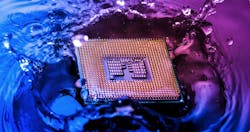This launches our article series on implementing hybrid liquid cooling solutions to navigate the complex interplay of AI, sustainability and operational efficiency.
The accelerated adoption of Artificial Intelligence (AI) is fueling an unprecedented surge in cooling demands within hyperscale and colocation data centers. Rack densities are skyrocketing, pushing the limits of traditional air-cooling infrastructure. While the promise of enhanced computing power and efficiency drives the move toward liquid cooling, the transition to full liquid cooling poses significant challenges, particularly for brownfield facilities with existing infrastructure. The high costs, potential for operational disruption, and lack of standardized practices create barriers to widespread adoption.
Data center operators are grappling with questions of scalability, sustainability, and cost-effectiveness. Addressing these pain points, this report champions a hybrid approach — a strategic combination of air and liquid cooling solutions. This offers a practical, cost- effective, and sustainable pathway for data centers to meet escalating cooling demands while conserving budgets and minimizing downtime.
This article series serves as a guide for data center professionals seeking to successfully implement hybrid cooling strategies, emphasizing the importance of flexibility and future-proofing in an ever-evolving landscape. Navigating the complex interplay of AI, sustainability, and operational efficiency requires a reliable partner.
Trane®, with its comprehensive portfolio of data center solutions and deep industry expertise, leads the market as a trusted advisor and innovator, uniquely positioned to help organizations navigate this complex transition and achieve their data center cooling and sustainability goals.
The Data Center Cooling Revolution
The confluence of AI, 5G, and high-performance computing (HPC) is driving unprecedented growth in data center capacity and power density. The demand for computing is exploding, driven by AI training and inference workloads that require massive processing power. Traditional air-cooling methods are struggling to keep pace with the increasing heat loads, as rack densities in air-cooled environments typically range from 15 to 20 kW per rack. This simply isn’t sufficient for modern AI deployments, where rack densities can easily exceed 100 kW, with some operators reporting even higher.
While liquid cooling offers a compelling alternative, promising superior heat removal capabilities, its widespread adoption is hampered by several significant barriers. These include high upfront investment costs, potential disruptions to existing operations during retrofits (particularly in brownfield data centers), and the current lack of industry standards and established best practices.
The transition to liquid cooling requires careful planning, significant capital investment, and a willingness to disrupt existing operations. However, there’s a growing recognition that a “perfect imperfection” will need to exist because the data center industry is evolving so rapidly that solutions need to be inherently adaptable and flexible. The rapid pace of technological change means that data center operators need to be able to adapt their cooling infrastructure quickly and efficiently.
Colocation providers are increasingly offering liquid cooling options to attract tenants with high- performance computing needs. The industry is experiencing an intertwined relationship between AI and sustainability, making hybrid solutions a present- day reality. Data centers are under increasing pressure to reduce their environmental impact, and liquid cooling offers a way to improve energy efficiency and reduce water consumption. The convergence of these trends is driving a fundamental shift in data center cooling strategies, with hybrid solutions emerging as a leading approach.
Download the full report, Hybrid for the Win: Optimizing Liquid Cooling Solutions Using Existing Air-Cooled Data Center Infrastructure, featuring Trane, to learn more. In our next article, we'll examine the allure and obstacles of full liquid cooling.





